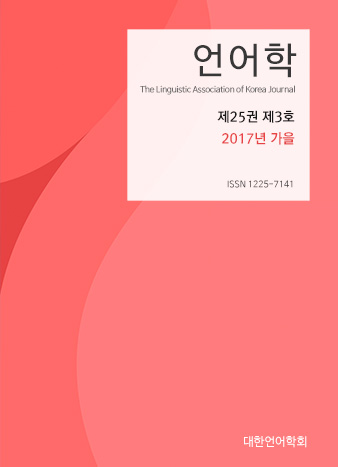대한언어학회 전자저널

25권 3호 (2017년 9월)
- The role of Korean -(n)un in comprehending negated disjunction on the direct object position
-
On-Soon Lee
Pages : 51-68
Abstract
Lee, On-Soon. (2017). The role of Korean -(n)un in comprehending negated disjunction on the direct object position. The Linguistic Association of Korea Journal, 25(3), 51-68. A Korean sentence like John-un ice cream-ina kheyik-ul an mek-ess-ta (John did not eat ice cream or cake) is temporarily ambiguous, permitting either the conjunctive interpretation (John ate neither ice cream nor cake) or the disjunctive interpretation (John did not eat ice cream or John did not eat cake). Yet theoretically, the topic marker -(n)un on the direct object position (ice cream-ina kheyik) forces the contrastive focus reading (Han, 1996). To assess the semantic effect of the Korean topic marker -(n)un in resolving this temporary ambiguity, a self-paced reading experiment with a Truth-Value Judgment Task was conducted with thirty native Korean-speaking adults. The participants chose the conjunctive interpretation more often in the topic-marked condition than in the accusative-marked condition. Moreover, their judgment times were shorter in the topic-marked condition. These results suggest that the semantic information carried by the topic marker -(n)un (i.e., contrastive focus) helps to resolve the temporary ambiguity of such sentences by reducing the processing load they impose.
Keywords
# topic marker # contrastive focus # disjunction # ambiguity # sentence processing
References
- Bornkessel-Schlesewsky I., & Schlesewsky, M. (2009). The role of prominence information in the real time comprehension of transitive constructions: a cross-linguistic approach. Language and Linguistics Compass, 3(1), 19-58.
- Chierchia, G., Crain, S., Guasti, G.T., Gualmini, A., & Meroni, M. (2001). The acquisition of disjunction: Evidence for a grammatical view of scalar implicatures. Proceedings of the 25th Boston University Conference on Language Development, 157-68. Somerville, MA: Cascadilla Press.
- Choi, H.-W. (1999). Optimizing structure in context: Scrambling and information structure. Stanford: CSLI.
- Cowles, H. W., Walenski, M., & Kluender, R. (2007). Linguistic and cognitive prominence in anaphor resolution: Topic, contrastive focus and pronouns. Topoi, 26(1), 3-18.
- Crain, S., & McKee, C. (1985). The acquisition of structural restrictions on anaphora. In Proceedings of NELS 16, 94-110.
- Crain, S., & Thornton, R. (1998). Investigations in universal grammar: A guide to experiments on the acquisition of syntax and semantics. Cambridge, MA: MIT Press.
- Fromkin, V., Rodman, R., & Hyams, N. (2011). An introduction to language. Boston, MA: Wadsworth
- Goro, T., & Akiba, S. (2004). The acquisition of disjunction and positive polarity in Japanese. In Proceeding of the 23th West Coast Conference Formal Linguistics, 101-14.
- Han, C. (1996). Asymmetric quantification: the case of the Korean topic marker-(n)un. In Proceedings of ConSOLE IV, 97-111.
- Han, C. (1998). Asymmetry in the interpretation of -(n)un in Korean. In Proceedings of Japanese and Korean Linguistics 7, 1-15.
- Kuno, S. (1973). The structure of the Japanese language. Cambridge, MA: The MIT Press.
- Kuroda, S.-Y. (2005). Focusing on the matter of topic: A study of wa and ga in Japanese. Journal of East Asian Linguistics, 14, 1-58.
- Laleko, O., & Polinsky, M. (2013). Marking topic or marking case: A comparative investigation of heritage Japanese and heritage Korean. Heritage Language Journal, 10, 40-64.
- Laleko, O., & Polinsky, M. (2016). Between syntax and discourse: Topic and case marking in heritage speakers and L2 learners of Japanese and Korean. Linguistic Approaches to Bilingualism, 6(4), 396-439.
- MacDonald, M. (1994). Probabilistic constraints and syntactic ambiguity resolution. Language and Cognitive Processes, 9(2), 157-201.
- MacDonald, M. C., Pearlmutter, N. J., & Seidenberg, M. S. (1994). The lexical nature of syntactic ambiguity resolution. Psychological Review, 101, 676–703.
- McRae, K., Spivey-Knowlton, M. J., & Tanenhaus, M. K. (1998). Modeling the influence of thematic fit (and other constraints) in on-line sentence comprehension. Journal of Memory and Language, 38, 283-312.
- O’Grady, W., Lee, O.-S., & Lee, J. (2011). Practical and theoretical issues in the study of heritage language acquisition. Heritage Language Journal, 8(3), 23-40.
- Spivey-Knowlton, M., & Sedivy, J. (1995). Resolving attachment ambiguities with multiple constraints. Cognition, 55, 227-267.
- Taraban, R., & McClelland, J. R. (1988). Constituent attachment and thematic role assignment in sentence processing: Influence of content-based expectations. Journal of Memory and Language, 27, 597-632.
- Trueswell, J. (1996). The role of lexical frequency in syntactic ambiguity resolution. Journal of Memory and Language, 35, 566-585.
- Trueswell, J., Tanenhaus, M. K., & Garnsey, S. (1994). Semantic influences on parsing: Use of thematic role information in syntactic disambiguation. Journal of Memory and Language, 33, 285–318.
- Trueswell, J., Tanenhaus, M. K., & Kello, C. (1993). Verb specific constraints in sentence processing: Separating effects of lexical preference from garden-paths. Journal of Experimental Psychology: Learning, Memory, and Cognition, 19, 528-553.
- Van Gompel, R. P. G., Pickering, M. J., & Traxler, M. J. (2001). Reanalysis in sentence processing: Evidence against current constraint-based and two-stage models. Journal of Memory and Language, 45, 225-258.